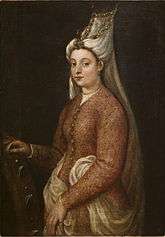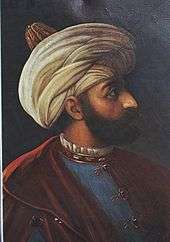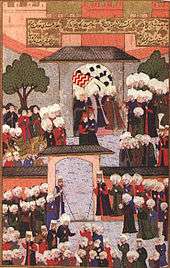Nurbanu Sultan
| Nurbanu Sultan نور بانو سلطان | |
|---|---|
|
Valide-i saadet-penah Mahd-i Ulya Sultanat El-Mütevekkil ala'llah El-melikü'l-mennan Valide-i Padişah | |
|
The türbe of Nurbanu located next to that of Selim II in the courtyard of Hagia Sophia | |
| Valide Sultan of the Ottoman Empire | |
| Tenure | 15 December 1574 – 7 December 1583 |
| Predecessor | Mihrimah Sultan |
| Successor | Safiye Sultan |
| Co-Valide |
Mihrimah Sultan until 25 January 1578 |
| Haseki Sultan of the Ottoman Empire | |
| Tenure | 7 September 1566 – 15 December 1574 |
| Predecessor | Hürrem Sultan |
| Successor | Safiye Sultan |
| Born |
Cecilia Vernier-Baffo or Rachel Olivia de Nasi c. 1525 Paros, Cyclades Islands, Republic of Venice |
| Died |
December 7, 1583 Istanbul, Ottoman Empire |
| Burial | Hagia Sophia Mosque, Istanbul |
| Spouse | Selim II |
| Issue |
Murad III Ismihan Sultan Gevherhan Sultan Şah Sultan |
| Father | Yosef de Nasi or Nicolò Venier |
| Mother | Violanta Baffo |
| Religion | Islam, previously Roman Catholic or Jewish |
Nurbanu Sultan (full style Haseki Afife Nûr-Banû Vâlide Sultân Aliyyetü'ş-Şân Hazretleri; Ottoman Turkish: نور بانو سلطان; c. 1525 – 7 December 1583) was the favourite consort and later wife of Sultan Selim II of the Ottoman Empire, mother of Sultan Murad III, and de facto co-ruler as the Valide Sultan for nine years from 1574 until 1583. She was either a Venetian of noble birth or a Spanish Jew.[1] Her birth name may have been Rachel Olivia de Nasi[2] or Cecilia Venier-Baffo.[3]
Theories about her origin
Currently, there exist two living theories about the ethnic roots of Nurbanu:
Rachel Olivia de Nasi
Yosef (Joseph) de Nasi, Duke of Naxos was the son of Samuel de Nasi, and the grandson of Yosef de Nasi, who was a tax farmer (collector) from Spain. Samuel de Nasi had a brother also named Yosef de Nasi who moved to Paros in the Greek islands.[4] At the time the Greek islands were under Venetian rule until the Muslim invasion of 1537.[4] The connections is revealed by the relationship of Rachel Olivia de Nasi who was born in Venice in 1525 to Yosef de Nasi, son of Samuel de Nasi, which places Rachel and Joseph de Nasi as second cousins, who was in a very close relationship with Nurbanu's husband.[4] Rachel was therefore related to Doña Gracia Mendes Nasi also known by her Christianised name Beatrice de Luna.[4] During the 1537 war on Páros, the Venetian born Rachel Olivia de Nasi was abducted and taken to the royal harem of Ottoman Prince Selim II in Istanbul and became his favourite wife.[4] She was renamed "Afife Nurbanu Sultan".[4] Being Jewish, she gave priorities to the Jewish people of Istanbul and Manisa.[4] The fact remains that Rachel was Nasi, which is proved by relationships.
Cecilia Vernier-Baffo
There has been some debate as to whose daughter Rachel Olivia de Nasi was.[4] The Venetian claimed she was the daughter of Nicolò Venier whose brother Sebastiano Venier (1496-1578), who became Doge of Venice between 1577 and 1578.[4] While the Turkish Muslims recorded that she was the natural daughter of Venetian Judean named Yosef de Nasi and Violanta Baffo, who ended up marrying Nicolò Venier.[4] Other entries confirm that Violanta Baffo was a mistress to Nicolò Venier, yet Yosef de Nasi is also recorded as the husband of Violanta Baffo.[4] More likely Nasi died, which allowed Baffo to remarry to Nicolò Venier (proven fact from relationships.[4])
Joseph de Nasi, Duke of Naxos, fled Venice to the Ottoman Empire of Prince Selim II and Rachel de Nasi.[4] This relationship unequivocally confirms that Rachel was the daughter of Yosef Nasi, brother of Benedetto de Nasi, which directly links the two Nasi families to Joseph de Nasi and Doña Gracia Mendes Nasi.[4]
Time as consort


Nurbanu became the most favored consort of Ottoman Sultan Selim II, who was put on the throne in 1566, and the mother of Murad III. She had been the head of his princely harem, however, when he became sultan, she was not head of the imperial harem, as that was a position taken by Selim's elder sister, the acting Valide Sultan, Mihrimah Sultan. Even after Selim began to take other concubines, she persisted as a favorite for her beauty and intelligence. As mother of the heir-apparent, she acted as an advisor to her husband. Although it was far from normal at the time, Selim II would often ask Nurbanu for her advice on various subjects because of his respect for her good judgment. Jacopo Soranzo, Venetian Ambassador reported:
"The Haseki is said to be extremely well loved and honored by His Majesty both for her great beauty and for being unusually intelligent."[5]
She was a devoted wife and a very loyal mother as later events would prove. The Ottoman Empire was far from being very stable at the top and clashes over the imperial throne were common. It was also not uncommon for the loser to have his entire family massacred along with him to prevent any future challenge. Nurbanu Sultan was determined, however, that when the time came for her son to succeed his father, nothing would interfere with that.
Valide Sultan and regent

Prince Murad had been sent to serve as Governor of Manisa on the Aegean coast and was there when Sultan Selim II died in 1574. This would have been the pefect opportunity for someone to seize power with the Sultan dead and his son away from the capital. Nurbanu realized this as much, if not more, than anyone and took quick action. Security and privacy in the harem were the most strict anywhere and no one knew when Selim II had actually died. Nurbanu told no one and hid the dead body of her husband in an icebox and sent to Manisa for her son to come to Constantinople immediately. All the while no one was the wiser that Sultan Selim II had actually departed this life. It was not made known publicly until twelve days later when Murad arrived and Nurbanu delivered up the body of her late husband. Her son became Sultan Murad III and Nurbanu became Valide Sultan, the highest position a woman could hold in the Ottoman Empire. However, once again, she was not completely in charge until the death of Mihrimah Sultan, four years after Selim's. When she did though, she became a formidable figure with far-reaching influence.
Foreign politics
After Nurbanu became the valide sultan to her son Murad III, she effectively managed the government together with the Grand Vizier Sokollu Mehmed Pasha, who acted as co-regent with the sultan during the Sultanate of Women. Her intermediary to the world outside the harem was her "kira", Esther Handali. "Kira" was so popular means of communication with the outside world when Nûr-Banû was the Valide Sultan that the two women were said to have been lovers. She corresponded with the queen Catherine de' Medici of France. Venetian accounts are the most prolific in describing Nurbanu Sultan as a woman who never forgot her Venetian origins.

During her nine years of regency (1574–1583), her politics were so pro-Venetian that she was hated by the Republic of Genoa. Some have even suggested that she was poisoned by a Genoese agent. In any case, she died at the palace in the Yenikapı Quarter, Istanbul on 7 December 1583. Moreover, it has been said that Nurbanu was related to Safiye Sultan, who was born Sofia Baffo, married Murad III, and consequently became the next valide sultan of the Ottoman Empire when her own son Mehmed III acceded to the throne. On the other hand, the Ottoman records claim that the Republic of Venice became highly dependent on the Ottoman Empire during the regency of Nurbanu because her policies were allegedly extremely pro-Jewish.
Charitable establishments and philanthrophy
During her nine years of regency, Nurbanu ordered the renowned Ottoman architect Mimar Sinan to build the Atik Valide Mosque and its surrounding külliye at the district of Üsküdar in Istanbul, where previously a "Jewish bath" was located. The construction of the külliye was completed and put in commission at the end of 1583, just before the demise of Nurbanu on 7 December 1583. She was buried at the mausoleum of her husband Selim II located inside the Hagia Sophia (then a mosque) at Sultanahmet in Istanbul, Turkey.
See also
- Ottoman Empire
- Ottoman dynasty
- Ottoman family tree
- List of Valide Sultans
- List of sultans of the Ottoman Empire
- Line of succession to the Ottoman throne
- Ottoman Emperors family tree (simplified)
- List of consorts of the Ottoman Sultans
References
Notes
- ↑ Stanford J. Shaw, History of the Ottoman Empire and modern Turkey, Volume 1, p. 178, at Google Books
- ↑ Godfrey Goodwin, The Private World of Ottoman Women, Saqi Book, ISBN 0-86356-745-2, ISBN 3-631-36808-9, 2001. page 128,
- ↑ Valeria Heuberger, Geneviève Humbert, Geneviève Humbert-Knitel, Elisabeth Vyslonzil, Cultures in Colors, page 68. ISBN 3-631-36808-9, 2001
- 1 2 3 4 5 6 7 8 9 10 11 12 13 14 Peter D Matthews (13 Jun 2013). Shakespeare Exhumed: The Bassano Chronicles. Bassano Publishing House. ISBN 978-0-987-36526-2.
- ↑ Peirce 1993, p. 228.
Sources
- Peirce, Leslie Penn (1993). The Imperial Harem: Women and Sovereignty in the Ottoman Empire. Studies in Middle Eastern History. New York: Oxford University Press. ISBN 978-0-19-507673-8.
- Goodwin, Jason, Lords of the Horizons, (1998) - page 160
- A.D. Alderson, The Structure of the Ottoman Dynasty. Clarendon Press, Oxford, 1956.
- Almanach de Gotha: annuaire généalogique, diplomatique et statistique, Justes Perthes, Gotha, 1880-1944.
- Burke's Royal Families of the World, Volume II: Africa & The Middle East, Burke's Peerage Ltd., London, 1980.
- Yılmaz Öztuna, Devletler ve Hanedanlar, Turkiye 1074-1990, Ankara, 1989.
- Osman Selâheddin Osmanoğlu, Osmanli Devleti'nin Kuruluşunun 700. Yılında Osmanlı Hanedanı, Islâm Tarih, Sanat ve Kültür Araştırma Vakfı (ISAR), Istanbul, 1999.
- Emine Fuat Tugay, Three Centuries: Family Chronicles of Turkey and Egypt, Oxford, 1963.
External links
| Ottoman royalty | ||
|---|---|---|
| Preceded by Hürrem Sultan |
Haseki Sultan 7 September 1566 – 15 December 1574 |
Succeeded by Safiye Sultan |
| Preceded by Mihrimah Sultan |
Valide Sultan 15 December 1574 – 7 December 1583 concurrently with Mihrimah Sultan: until 25 January 1578 | |
| ||||||
|